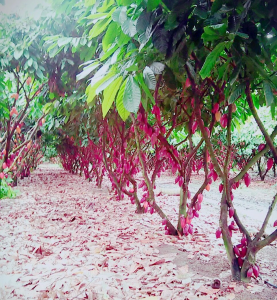October 5th, 2018 – The Royal Automobile Club, 89 Pall Mall, London SW1Y 5HS
The Academy of Chocolate (AoC) was established to:
- • promote and encourage excellence in the production of chocolate
- • foster and develop an appreciation amongst consumers, of the wonders of fine chocolate
- • promote the highest standards of agronomy, social engagement and environmental stewardship, in the cultivation of fine flavour cocoa.
In theming the 2018 biennial conference ‘A World Without Chocolate’, the AoC sought to draw attention to the personal importance of chocolate to so many people around the world, whether as a ‘pick-me-up’, a treat, or a small but luxurious indulgence, or perhaps too, as a livelihood, and the theme also  sought to highlight the importance of chocolate as a significant value chain in the global economy. The prompt for the conference theme was provided by the mounting concerns, reflected across diverse media platforms, of the potentially devasting impact of climate change on the West African cocoa growing countries, which now produce more than 70% of the global crop.
sought to highlight the importance of chocolate as a significant value chain in the global economy. The prompt for the conference theme was provided by the mounting concerns, reflected across diverse media platforms, of the potentially devasting impact of climate change on the West African cocoa growing countries, which now produce more than 70% of the global crop.
The Risks To Our World of Chocolate
In 2011 the Colombia-based International Centre for Tropical Agriculture (CIAT) noted that an expected rise in temperature of more than 2 degrees Celsius by 2050, would leave many of West Africa's cocoa-producing areas too hot for the production of cocoa. The CIAT team postulated that production in many areas could start to decline by 2030, if average temperatures increased by 1 °C , as some climate models suggest. Research highlighted in the Intergovernmental Panel on Climate Change (IPCC) Climate Change 2014: Impacts, Adaptation, and Vulnerability report, indicated that, under a “business as usual” scenario, the top producer countries of cocoa, Ivory Coast and Ghana (circa 50%-60% of the global crop) will experience a 3.8°F (2.1°C) increase in temperature by 2050, and a marked reduction in the cultivation area suitable for cacao. It is feared that “the higher temperatures projected for West Africa by 2050, are unlikely to be accompanied by an increase in rainfall, according to business-as-usual carbon dioxide emissions scenarios”. With greater loss of moisture to evaporation, reducing levels of rainfall, will lead to a drier, less humid environment.
While climate change is a clear and developing menace, so too are deforestation and diseases. Nicko Debenham, Vice-President, Head of Sustainability for Barry Callebaut AG, presented to the Conference, time series satellite mapping of the West African forests, revealing progressive, significant and widespread deforestation. According to www.mongabay.com (2014), available data indicates that between 1900 and 1950, 4.2 million hectares of forests were degraded in Ghana out of a total of 8.4 hectares at the beginning of the century. The FAO estimated that in 1992, only about 1.5 million hectares of "intact closed forest" were remaining in Ghana. Deforestation during the period 1990-2000 was estimated at about 135,000 hectares per year and during the period 2000-2005 it was estimated to be 115,000 hectares per year (FORESTRY COMMISSION, 2010). https://theredddesk.org/countries/ghana/statistics. In Ivory Coast the scale of deforestation has been increasing. Note the Guardian Newspaper website report (Wed 13 Sep 2017) ‘Chocolate industry drives rainforest disaster in Ivory Coast’, by reporter Ruth Maclean from Marahoué national park, Ivory Coast. The Guardian travelled across Ivory Coast and documented “rainforests cleared for cocoa plantation; villages and farmers occupying supposedly protected national parks; enforcement officials taking kickbacks for turning a blind eye to infractions and trading middlemen, who supply the big brands, indifferent to the provenance of beans”. Destroy the rainforests and the risk is that the delicate ecosystem and climate inter-relationship is also lost, and with it, the environment needed to cultivate cocoa successfully.
Then there is disease, and in particular Cocoa Swollen Shoot Virus (CSV). Pamela Thornton of Armajaro Nightingale Investment Management, one of the most experienced physical cocoa traders of her generation, described to the Conference, the impact of CSV in Ivory Coast, estimating that up to 80% of the country’s orchards were affected, with consequential impact on yields for the lifetime of those orchards. The risk to the global cocoa value chain from this threat is magnified by the concentration of 60% of the world crop in just two countries The cocoa world has witnessed already catastrophic disease outbreaks, the most virulent to date: Witches’ Broom, a much-feared disease of cocoa in the Americas. The Conference heard from Susana Cardenas of Cardenas Chocolate how the cacao culture of Manabi Province in Ecuador was brought to its knees and almost lost, when Witches’ Broom struck in the early 1920s. When it arrived in Brazil’s Bahia region, the disease cut production by nearly 70% over a period of 10 years. Moniliophthora perniciosa is the fungus responsible for Witches' Broom disease. During the last century the fungus spread throughout all of South America, Panama and the Caribbean, causing serious losses in production. The fungus attacks only actively growing tissue (shoots, flowers and pods) causing cocoa trees to produce branches with no fruit and ineffective leaves. Once the largest producer of cocoa beans in the world with annual crops as large as 430,000 MT, Brazil suffered dramatically in 1989 when Bahia, the country’s main cocoa-producing area, was infected with Witches’ Broom. Again in 2012, Brazilian cocoa bean production was reported down by some 15% to 194,382 MT, impacted by another outbreak of Witches’ Broom. Repeated outbreaks of WB since the 1980s have displaced Brazil from the position of top producer country and acted as a brake on planting rate.
Cocoa based consumer goods annually generate global sales of $120bn, representing a significant and important value chain in the global economy. Simon Wright, the UK representative for Italian chocolate manufacturer ICAM, detailed to the Conference that cocoa based consumer goods now represent 33% of all ambient grocery lines. The value chain is not only critical to the 6-8 million small farming families across the tropical belt who produce cocoa beans, but also to hundreds of thousands of workers in processing plants and retail outlets across the globe.
An Upstream Sector In Transition
In the morning session of the Conference, a number of speakers including Pamela Thornton and Nicko Debenham, drew to the attention of delegates the fragile state of cocoa production in West Africa. Farming methods are the most basic kind, planting materials are largely whatever is to hand, logistics are inadequate, and the farmers themselves are ageing and in too many cases, living below the poverty line – and Conference heard that this has been the case for more than 30 years. This, the Conference concluded, was not sustainable.
Delegates asked the Conference to consider how these data impacted on consumer sentiment and behaviour. Consumers are becoming increasingly aware of product sourcing, and there is rising concern amongst younger consumers in particular, that the products they use should be sustainably and ethically produced. Chocolate is barely consumed in Africa; the retail and distribution infrastructure of much of Sub-Saharan Africa, cannot maintain the quality integrity of chocolate goods; making chocolate very largely, a ‘first world luxury’. ‘First World’ consumers are increasingly concerned that their luxuries, should not be enjoyed against a backdrop of poverty amongst developing world producers. The Conference also heard from speakers and delegates in the conference auditorium, that governments in producer countries had failed to address systemic barriers to the development of progressive and modern agricultural economies in their countries, with specific recommendations to address land tenure systems, rural infrastructure, education and training, and the provision of superior planting materials. Subsistence farming as an economic model was called into question: some 68% of the labour force in Ivory Coast is engaged in agriculture, yet in the most developed economies of the world, agriculture absorbs less than 2% of the labour force, as modern farming techniques and mechanisation impact positively on productivity. The Conference concluded that if subsistence farmers were to be lifted out of poverty, agriculture had to become more efficient and that governments have a role to play in creating greater employment opportunities, if farms are to become scaled and efficient. From the Conference room delegates from West Africa described the challenges for young people in the cocoa growing regions, deprived of facilities and amenities. There is already a significant drift to the cities across Africa, and this demographic pattern also threatens the stability of cocoa supplies from the region.
In reminding the Conference of Ecuador’s 300-year old cocoa culture, Susana Cardenas, drew attention to the very different model of cocoa production that is evolving in South America. The Conference heard from Professor Paul Hadley (Crop Physiology, Reading University) that modern ‘high-tech’ experimental orchards in Brazil and Ecuador were able to demonstrate the attainment of 7.5 MT of cocoa per hectare, 19x the yield achieved on most West African farms. Reviewing the risks implied by climate change risk, the pernicious and creeping deforestation of West Africa, an ageing farmer cohort and the lure of urban lifestyles for the younger generation, the Conference identified that the global pattern of cocoa production is now likely to be transitioning, whether by design or force of circumstance, from a pattern of agriculture unchanged for half a century, to a model that can be expected to draw on the experience, culture and experimentation of the Americas.
Salvation in Science
While the morning half of the Conference contemplated the risks to the cocoa value chain that might result in a World Without Chocolate, or certainly a world in which chocolate had become scarcer, the afternoon session began with a review of the solutions offered by science. Professor Hadley detailed the work undertaken at the International Cocoa Quarantine Centre at Reading University, and at other leading research institutions, to identify genetic traits in cocoa varieties capable of conferring disease tolerance and drought tolerance, in short to support the work of breeding establishments in generating new varieties of cacao able to survive the perils threatening the crop. However, one priority above all others was presented to the Conference by Tony Lass, an agronomist, and formerly Director of Global Cocoa Supplies for Cadbury’s. Tony reminded the Conference that the planting stock across West Africa derives from no more than 10-15 Amazonian lines taken to Africa in the 19th Century, and this accounts for perhaps as much as 80% of the world crop. However, in the two international, gene-bank repositories for cacao, CATIE in Costa Rica and The International Cocoa Gene-bank in Trinidad, some 3,000 distinct genotypes have been curated. How much more diverse and interesting might our chocolate be, if the global harvest was drawn from a wider range of cocoa varieties, and how much more secure might global supplies be, if they were also drawn from a wider range of varieties? Within this assembly of genetic material might be elevated tolerance to Witches’ Broom and CSV, or even aridity. Mr Lass raised as a concern, the inadequate nature of funding for managing, preserving and utilising these stores of unique cocoa genetics. It is possible that within this store of genetics that there are flavours and aromas that could be revolutionary in the production of fine chocolate.
The Role of Consumers
While the Conference concluded that the world is unlikely to be without chocolate, given its importance to consumers and the global economy, speakers and delegates shared the fear that the current model could be significantly disrupted by the risks which had been highlighted, with damaging consequences for actors right along the value chain from small farmers to consumers. Delegates questioned what role the consumer could play in shaping the dynamics of the value chain. Speakers from the manufacturing and retail sector drew attention to the interest of modern consumers in the provenance, in the quality, and in the flavour of chocolate. A consumer focus on these characteristics implies a move away from bulk confectionery to premium products, and this trend is very evident across the sector. The premium end of the downstream chocolate confectionery market has been estimated to represent around 11%-12% of the total market (Agronomy Capital Advisors Ltd), for a value of some $11bn-$12bn in annual consumer sales, and enjoying growth of as much as 8% per annum, in contrast to slowing and even negative growth rates for mass chocolate confectionery. This consumption trend in favour of premium chocolate confectionery is premised on a better, purer, healthier chocolate experience for consumers.
The AoC has witnessed this trend at first hand: in 2006, the AoC held its first ‘Taste Awards’, receiving no more than 20 entries from perhaps 6 brands. In 2018, by contrast, the AoC ‘Taste Awards’ received some 1,200 entries from 220 distinct brands. The preference of modern consumers for high quality chocolate has seen an explosion of brands in the premium and super-premium segment of the global chocolate market. This trend echoes the founding objectives of the AoC, and it underscores how consumers can help to ensure the health and robustness of the entire cocoa value chain, by insisting on truly sustainably sourced cocoa, and the production of high quality, fine flavour chocolate, which as a category, pivots on the distinct genetics of the cocoa trees themselves.
Doug Hawkins, Chairman Agronomy Capital Advisors Ltd; Member of Academy of Chocolate.

